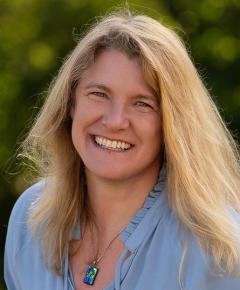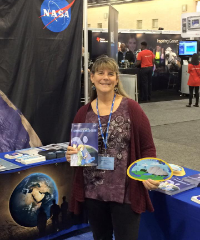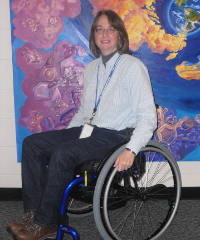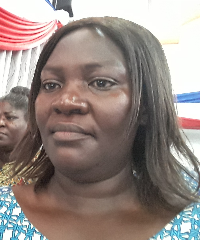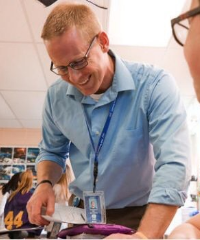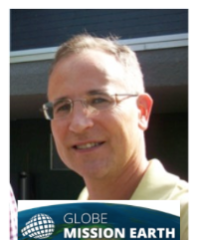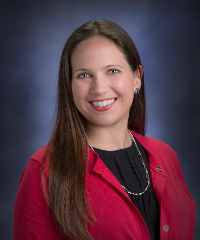Community Blogs
Community Blogs
Discover how the GLOBE community is engaging in all things GLOBE through the community blog posts below.
Learn how to create a GLOBE community blog post.
Filter By:
Blogs List
In an earlier blog, I referred to Elaine Reese, a child psychologist who measured emerging narrative identities of 40 month old children. The validity of her study is corroborated by other researchers and I am satisfied. I therefore direct my task to compiling best practices of ERE and to suggest settings that can lead to ERE events with GLOBE content. My hope is that parents will imagine the applicability of one or more of these settings, make them happen, and share their success stories for other parents to emulate.
This blog shall serve to chronicle community action in ...
Read More »
Posted in:
Before the L.A. GLOBE Conference in 2015, I sent a request to Gwynne Shotwell for a mini-learning expedition to the Space X HQ in Hawthorne. The HQ could only take a small group and it included the GLOBE Africa Coordinator, a GLOBE Japan Partner and Trainer, a GLOBE Japan teacher, GLOBE students from San Diego and their parents.
Since then GLOBE training in Okinawa focused on Integrated One Day Atmospheric Measurements and the Cloud Cover Protocol, using the app GLOBE Observer. Trainees are introduced to the satellites that measure clouds from above and that we ...
Posted in:
Are you taking GLOBE water quality measurements as part of the ENSO Student Research Campaign? If so, please consider joining the new GLOBE Water Quality Collaboration Group (GWQCG) .
Led by Bob Connick, GLOBE schools from across the world are taking water quality measurements that help explore one of the ENSO Campaign's Guiding Investigative Questions, "What is the quality of water in our environment?"
By learning all about the water quality measurements in a local setting, one can learn just how these local measurements helps us understand the global picture of water ...
Posted in:
Field Campaigns:
EL NIÑO
GLOBE Working Groups:
SCIENCE WORKING GROUP
EDUCATION WORKING GROUP
Investigation Areas:
ATMOSPHERE
EARTH AS A SYSTEM
HYDROSPHERE
PEDOSPHERE (SOIL)
BIOSPHERE
Primary Audience:
TEACHERS
TRAINERS
STUDENTS
PARTNERS
SCIENTISTS
COUNTRY COORDINATORS
ALUMNI
I've been digging through my Inbox, trying to clear out some of the large files from the past. I'm at a critical point as these files are triggering invitations to buy more space for storage. Rather than doing that, I'm deleting instead!
But during this process, I've come across some resources and discussions that I always seem to forget exist already on the GLOBE website. I thought that perhaps I'd write a couple blog posts and point out some of these for anyone following my blog.
This first one is a training agenda from 2003! A group of us were invited to Washington, D.C. to work ...
Posted in:
Curriculum:
SCIENCE AND MATH
GLOBE Science Topics:
GENERAL SCIENCE
GLOBE PROTOCOLS
SCIENTIST SKILLS
Investigation Areas:
BIOMETRY (INCLUDING TREE HEIGHT)
BIOSPHERE
LAND COVER CLASSIFICATION
We had a fabulous webinar this afternoon in which students in both North America and South America shared their work on using GLOBE protocols to learn more about water in their environment. Meriam Kalloe, the GLOBE Assistant Country Coordinator for Suriname, brought together many students from Anton Resida Middle School who shared information on their use of several GLOBE hydrology protocols to study the quality of water in three locations near their school. They plan to continue to monitor the quality of the water in those three sites. Then Jeff Bouwman's middle school students ...
Posted in:
Curriculum:
STEM
SCIENCE AND MATH
Event Topics:
CAMPAIGNS AND PROJECTS (IOPS, ETC)
SCIENCE SYMPOSIA AND FAIRS
Field Campaigns:
EL NIÑO
SMAP
GPM
GLOBE Science Topics:
EARTH SYSTEM SCIENCE
GENERAL SCIENCE
GENERAL SCIENCE @ES
CLIMATE CHANGE
DATA INCLUDED
BACKYARD SCIENCE
MEETINGS/CONFERENCES
CLIMATE
EARTH AS A SYSTEM
SCIENTIST SKILLS
GLOBE PROTOCOLS
GLOBE Working Groups:
EDUCATION WORKING GROUP
Investigation Areas:
ATMOSPHERE
EARTH AS A SYSTEM
HYDROSPHERE
PEDOSPHERE (SOIL)
BIOSPHERE
Learning Activities:
EARTH AS A SYSTEM
ATMOSPHERE AND CLIMATE
LAND COVER/BIOLOGY
HYDROLOGY
SOIL
News Topics:
VIRTUAL SCIENCE FAIR
SCRC RESEARCH
Primary Audience:
PARTNERS
SCIENTISTS
ALUMNI
COUNTRY COORDINATORS
TRAINERS
TEACHERS
STUDENTS
Teacher's Guide:
INVESTIGATION AREA DOCUMENTS
A Very Special ENSO Student Research Campaign SODA Webinar will begin in 1 hour. The webinar will be live from Puerto Rico and will focus on Water Quality after Hurricane Maria. Two student teams from the Ramey school will be presenting their GLOBE ENSO research today.
Learn more HERE!
Join us at: https://zoom.us/j/7578241037
Posted in:
Field Campaigns:
EL NIÑO
Investigation Areas:
ATMOSPHERE
EARTH AS A SYSTEM
HYDROSPHERE
PEDOSPHERE (SOIL)
BIOSPHERE
Primary Audience:
TRAINERS
TEACHERS
STUDENTS
PARTNERS
SCIENTISTS
ALUMNI
COUNTRY COORDINATORS
This week we are very excited to highlight the work of Ms. Jillian Anderson and her high school students at the Lexington School for the Deaf, in Queens, NY.
Ever since they joined the U.S. GLOBE Air Quality Student Research Campaign, they have been going outside to make observations of the atmosphere every day! The students have been submitting both Clouds and Aerosol Optical Thickness observations and we want to thank them for their valuable contribution to science.
We encourage them to keep up their great work and we invite other schools to continue ...
Posted in:
Curriculum:
STEM
GLOBE Science Topics:
SCIENTIST SKILLS
GLOBE PROTOCOLS
GLOBE Working Groups:
SCIENCE WORKING GROUP
Investigation Areas:
AEROSOLS
Primary Audience:
TEACHERS
STUDENTS
PARTNERS
SCIENTISTS
We breathe in the oxygen they produce, clamber up their branches, pick their delicious fruits and sit in their shade – and now it’s time for trees to have the spotlight!
NASA’s ICESat-2 mission wants to meet you and your favorite tree. It could be a giant sequoia or a maple sapling, a wetland mangrove or a desert cactus. It could be a favorite climbing tree, a place for reflection, a support for a swing, or anything else meaningful to you. Create a short video starring you and your tree, and it could be included in a NASA video feature on an upcoming citizen science project.
In ...
Posted in:
At 5:00pm EDT (9:00pm UTC), we will be hosting the next ENSO Short Observation & Data Analysis (SODA) Webinar: Live from Stratford, Connecticut! The topic being presented by students today is "Does Data Drive Questions or Do Questions Drive Data?"
Learn More About it HERE!
Join us today at 5:00pm EDT at https://zoom.us/j/7578241037
Posted in:
Field Campaigns:
EL NIÑO
Investigation Areas:
EARTH AS A SYSTEM
ATMOSPHERE
HYDROSPHERE
PEDOSPHERE (SOIL)
BIOSPHERE
Primary Audience:
TRAINERS
TEACHERS
STUDENTS
PARTNERS
SCIENTISTS
ALUMNI
COUNTRY COORDINATORS
Have you ever wondered how to collect data using a GLOBE protocol and compare that data to that of a satellite flying at over 15,000 Mph (24,140 Kmh)? A group of freshman students, under the instruction of Dr. Jodi Haney, at Bowling Green State University did just that.
As part of the ENSO Student Research Campaign , these students conducted research by collecting soil moisture , surface temperature , cloud cover , and relative humidity. Date-stamped comparisons were conducted among all these variables.
The student compared several data variables in their research ...
Posted in:
Field Campaigns:
EL NIÑO
SMAP
Investigation Areas:
HYDROSPHERE
PEDOSPHERE (SOIL)
ATMOSPHERE
Primary Audience:
TRAINERS
TEACHERS
STUDENTS
PARTNERS
SCIENTISTS
ALUMNI
COUNTRY COORDINATORS
GLOBE Ghana in collaboration with UNESCO Office in Ghana and Regional Environmental Office for West and Central Africa at American Embassy Ghana, EPA AND TWUMY Graphy organised this year's Earth Day Celebration on the 24th of April, 2018, under the Theme Connecting the Public and Classroom to Climate Change and Plastic Pollution. About 80 people including GLOBE students, Ghana police and Military Education Directorate, the Clergy, STEM coordinators, Scientists, Education Directorsl and many more attended the programme
The Director General of Ghana Education ...
Posted in:
Greetings from Grosse Ile, Michigan (United States of America)! Recently, I had the honor of being published in the National Science Teachers Association's (NSTA) April/May 2018 edition of Science and Children with my good friend, Dr. Stein Brunvand (Associate Dean - University of Michigan - Dearborn - College of Education, Health, and Human Services ). Dr. Brunvand and I shared some ideas for introducing Citizen Science and technology in an elementary classroom setting. Many of these best practices were utilized when I was a fifth grade teacher at Frank E. Weiss Elementary ...
Posted in:
Curriculum:
STEM
SCIENCE AND MATH
Field Campaigns:
SMAP
GLOBE Science Topics:
GLOBE PROTOCOLS
Investigation Areas:
SOIL MOISTURE - SMAP BLOCK PATTERN
PEDOSPHERE (SOIL)
Primary Audience:
TRAINERS
STUDENTS
TEACHERS
We would like to share with you some tips on how to keep your Calitoo instrument up and running:
Keep your instrument indoors until the time of measurement. The instrument detector is sensitive to temperature and performs best near room temperature (~70F or ~21C).
Don’t let your instrument overheat. Also don’t make measurements in extreme cold unless instrument is insulated from cold.
Don’t forget to TURN OFF your instrument after you’re done measuring! To turn off, press the button for a few seconds until the screen reads: “ Stop in progress ”.
When batteries start going ...
Posted in:
This has been a great year for the Urban Heat Island/Surface Temperature Student Research Campaign. More schools and more students have participated than ever before. I posted a 7 minute "Thank You" video here on https://youtu.be/QPfmAbMrwE4 Youtube. Urban Heat Island is a growing issue worldwide. More than 50% of the population of the world lives in urban areas. Much of this growth has been in developing. I went to research presentations about UHI at the American Association of Geography (AAG) meeting in New Orleans this week. There were many talks about UHI and using satellite imagery ...
Posted in:
Field Campaigns:
SURFACE TEMPERATURE
Eight-grade students from Our Lady of Mount Carmel School have been very active during our GLOBE 2017-18 U.S. Air Quality Student Research Campaign. In fact, they recently submitted their team projects to the GLOBE 2018 International Virtual Science Symposium. All students have done remarkable work and one of the most important skills they have developed is collaboration. Among these students, one of them stood out for becoming a Calitoo expert user and for helping not only the members of her own team, but also the members of all other teams, with her accurate AOT measurements.
This ...
Posted in:
Curriculum:
STEM
SCIENCE AND MATH
Event Topics:
CAMPAIGNS AND PROJECTS (IOPS, ETC)
GLOBE Science Topics:
GENERAL SCIENCE
EARTH SYSTEM SCIENCE
GLOBE PROTOCOLS
GLOBE Working Groups:
SCIENCE WORKING GROUP
Investigation Areas:
AEROSOLS
Primary Audience:
TEACHERS
STUDENTS
PARTNERS
Did you know that NASA Applied Sciences has a Water Resources Program?
Check it out HERE!
Posted in:
Field Campaigns:
EL NIÑO
Investigation Areas:
ATMOSPHERE
EARTH AS A SYSTEM
HYDROSPHERE
PEDOSPHERE (SOIL)
BIOSPHERE
Primary Audience:
TRAINERS
TEACHERS
STUDENTS
PARTNERS
SCIENTISTS
ALUMNI
COUNTRY COORDINATORS
Візит делегації вихованців та педагогів
Івано-Франківської міської дитячої екологічної станції
до
середньої школи с.Шааб, що в Ізраїлі
Людей і держави зближують спільні повсякденні клопоти й прагнення. Ми маємо спільне бажання створити нове, щасливе майбутнє для наших людей. Спасибі вам за плідну співпрацю між нашими чудовими містами й країнами!
Хочемо подякувати за теплий прийом, гостинність і захоплюючу культурну програму, надану нам під час візиту.
Впродовж 22-27 березня 2018 року, делегація учнів та педагогів Івано-Франківської міської ...
Posted in:
The GLOBE Clouds team got to celebrate World Meteorological Day with the Secretary-General of the World Meteorological Organization, Dr. Petteri Taalas through a Facebook live filmed live from NASA Langley Research Center in Hampton, VA.
Join the celebration by watching the recorded Facebook live below.
View event on Facebook at - https://www.facebook.com/nasaearth/videos/10156418942207139/
Posted in:
Curriculum:
STEM
EDUCATION RESEARCH
SCIENCE AND MATH
Event Topics:
OTHER
GLOBE Science Topics:
GENERAL SCIENCE
BACKYARD SCIENCE
Primary Audience:
TRAINERS
TEACHERS
STUDENTS
PARTNERS
SCIENTISTS
ALUMNI
COUNTRY COORDINATORS
Water quality is a very important environmental variable that must be actively monitored. Water quality differs everywhere across the planet and is vital to human health and survival. One of the three ENSO Student Research Campaign's 'Guiding Investigative Questions' says, " What is the quality of water in our environment? " This question opens up a new level of observation, research, and action. Students from around the world are taking measurements through several GLOBE Protocol including, but not limited to:
pH
Alkalinity
Dissolved Oxygen
Water Transparency ...
Posted in:
Field Campaigns:
EL NIÑO
Investigation Areas:
EARTH AS A SYSTEM
ATMOSPHERE
HYDROSPHERE
PEDOSPHERE (SOIL)
BIOSPHERE
Primary Audience:
TRAINERS
TEACHERS
STUDENTS
PARTNERS
SCIENTISTS
ALUMNI
COUNTRY COORDINATORS
Today we will get a closer at look at the values displayed on our Calitoo screen.
When you first turn on your Calitoo, you will get a screen like the following: note the serial number of your instrument will be displayed.
After the initial screen, your instrument will display basic information as shown on the following picture (Source: http://www.calitoo.fr/uploads/documents/en/usermanual_2016_en.pdf )
TIP: The temperature displayed by your Calitoo is actually the temperature ...
Posted in:
Event Topics:
CAMPAIGNS AND PROJECTS (IOPS, ETC)
SCIENCE SYMPOSIA AND FAIRS
GLOBE Science Topics:
EARTH SYSTEM SCIENCE
GLOBE PROTOCOLS
GLOBE Working Groups:
SCIENCE WORKING GROUP
Investigation Areas:
AEROSOLS
News Topics:
VIRTUAL SCIENCE FAIR
Primary Audience:
TRAINERS
TEACHERS
STUDENTS
PARTNERS
—
20 Items per Page








